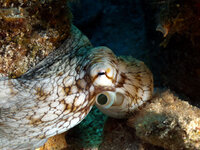I have not been called that since my teens

The look is similar but you can't count on looking for it when feeding as they will also use the arm normally. Some males make a bigger show of keeping the arm curled than others. I replayed the video several times and can't determine which arm I was looking at but I believe that WAS the third arm on the right and the tip appeared darker so the answer is MAYBE. Keep observing as he starts to come out more. Did you find the photo collection on sexing your octo (the blue type is a link in post #12)? There are several good shots there that will help you see what you are looking for. Of course SueNami ended up being a boy named Sue because that arm was missing when he came to the aquarium. I assumed that, since it is normally protected and less likely to be missing in a male, he was a she. Not until the arm grew back was it clear that he was careless with his reproductive conduit. There is also a channel that runs down the arm and the arm tip is somewhat funnel shaped and will not have suckers. I can almost never see the channel or tip difference in a live animal but I have been able to find it in well focused pictures. The arm curl is quite distinct and is seems that older the animal is the more often it the arm is kept rolled up.
As an interesting aside, there is one octopus (Ameloctopus litoralis) that sheds its arm at sexual maturity and grows a new one. The original arm does not have the channel or ligula (specialized tip). There is another, the Paper Nautilus (Agronauta, more than one species), that completely loses its hectocotylus when it mates. It is unclear if the arm is, as sometimes reported, thrown at the female or he just lost during mating. The specialized arm is called a hectocotylus and when found in the Argonaut was originally thought to be a new parasitic worm. The name remained when its actual function was clarified. Note that, in spite of what you will read on the net, the hectocotylus is a conduit for the sperm packets and not the penis (which exists but is found inside the mantle).
Oh, and when referring to cephalopods, octopuses have 8 arms, squid and cuttlefish have 8 arms and 2 tentacles. Often you will see the words used interchangeably but the distinction is important in cephs. The extra appendages are
part of what defines the difference between a squid and an octopus and helps define their feeding methodology.



